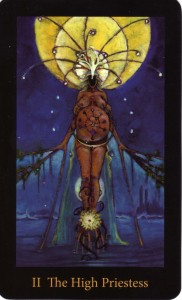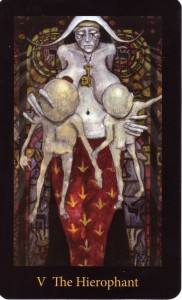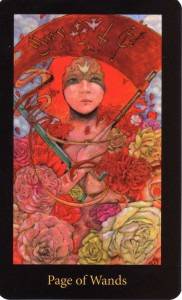The Mary-El Tarot
Posted by: TheReviewer on: March 29, 2012
- In: Deck Reviews | Featured | Latest Decks
- Comment!
I’ve waited ten years to hold this beautiful creature of art and mystery in my hands. Ten long years in the making, and here it is at last… and it takes my breath away. It heats up my blood and sends it coursing through me, making the warmth rise in my cheeks and spread down, deeper. There’s something about the Mary-El Tarot that gets right inside me: it doesn’t just speak to me, but rather it grabs me by the heart, guts, and loins and pulls me down a rabbit hole of wonder and terror and amazement. This deck turns me on… in so many ways. They say a picture is worth a thousand words, but the pictures in the Mary-El Tarot are worth the silence that leads to true wisdom, the long meditative contemplation that leads to “Aha!â€
The creatrix of the Mary-El, Marie White, states in “Landscapes of the Abyssâ€, the companion book for the deck, that “The Mary-El Tarot is built on the three pillars of the Marseille, Rider Waite, and Thoth decks, in deep respect of their wisdom and tradition…†(pp.13) Indeed it is a perfect synthesis of these three great traditions, resulting in card images that may not be familiar for those firmly
entrenched in what has become “modern†(read: RWS clone that is just a pretty face) Tarot, but rather giving us a set of cards that reveal so many mysteries of symbolic systems that have informed the development of card meanings that I nearly wept with joy. Never before have I seen the Kabbalistic system of the Minor Arcana presented so succinctly, beautifully, powerfully and accessibly in a Tarot deck… not even in Crowley’s Thoth.
There are some decks that are great for divination. The Mary-El Tarot is not one of them. This is, perhaps, it’s only downside. But it leads directly to what is one of its greatest strengths: this isn’t just a fortune-telling deck, it is food for the soul. Not only in the artwork itself, but in the companion book, which adds to the reader’s understanding of the cards as well as their understanding of the universe. This might go some way to explaining the companion book’s title, as it really is a guidebook to the “Abyss†– the darkest recesses of the human experience. Now, one might be forgiven for looking at the Mary-El Tarotand judging it immediately as a “dark†deck, or even a “gothic†deck. It is neither of these things, however. The artwork is only dark in as much as it is rich, and does not hold itself back, creating at times quite disturbing images (V The Hierophant being the one that does it for me). The theme, despite the abyssal language and heavy black card borders, card backs and the box and guidebook colouring is not in any way “darkâ€, but perhaps heavy for those who are not briefly familiar with Kabbalah and the fact that the cards are called “Arcana†for a reason.
The Mary-El Tarot is a standard 78-card deck with scenic Minor Arcana, numbering in the Marseilles tradition (VIII Justice and XI Strength) and RWS Major Arcana titles. It uses the Thoth’s suits (Disks rather than Pentacles or Coins), but the RWS Court Cards of Page, Knight, Queen and King. It is far larger than your average deck, (14cm by 8.5cm) which is a nuisance for small hands but a blessing for the artwork on the cards. (Tip: shuffle the deck vertically rather than horizontally.) Each card has a thick black border around it with titles in the border beneath, and the card backs show a double ouroborous in the shape of two interlocking circles (or a vessica piscis). The card stock itself is sturdy, with a high-gloss finish, meaning the deck will last a long time. It comes packaged in a magnificent box with magnetic sealing and a flip-top lid, along with the 192-page companion book. The only disappointment with this deck for me came with the printing itself: several of the cards in my copy of the deck have the images printed more to one side of the card, leaving a wider border width on one side than the other. However, it took me a number of viewings to stop being so enamoured with the card images that I noticed this.
The images in the deck are striking, intriguing, beautiful and powerful. There are a great many details that reveal themselves the more you look at the cards – such as the patterns formed upon the stomachs of the four cherubs on the four Aces, and the differences in pattern – and a number of motifs that reappear throughout the deck, highlighting shared symbolism and meaning. Ravens, wolves, and big cats (particularly the alchemical lion) are three such symbols, linking Major and Minor Arcana throughout the deck. The Mary-El also has a coherence that many decks today lack, probably due to its foundation in Kabbalah. All the Aces have something in common, all the Twos, all the Threes… for instance, all the Sixes are represented by the four archangels, all the Fours are scenes of nature, completely devoid of people, all the Tens are the apocalyptic horsemen. I particularly love the Fives and
Sevens: the Five of Wands and Cups are represented by the alchemical pairing of red lion and white unicorn; the Five of Swords and Coins are represented by Eve and Adam (altogether they are the Garden of Eden) . With the Sevens we find the black and white wolves from VII The Chariot, and Odin’s two ravens, Hugin and Munin. (Fun fact: the original Mary-El Majors + Aces, limited edition deck from 2003 bore a title card for the artist’s signature, upon which was a black raven with a green gem in its mouth… a motif that appears on the Seven of Swords image in the 2012 edition.)
The Mary-El Tarot has achieved what I see as the “redemption†of the Fives and Sevens – no longer the arbitrary meanings of “loss†and “grief†for the Five of Cups, or “financial loss†for the Five of Coins. There are deeper messages in these cards than this, but they do not lose their element of challenge and suffering. In fact, where some modern decks have made the more negative cards lighter or gentler, changing perspective to soften their blow, the Mary-El Tarot deepens every single card. Suddenly the gap between Major and Minor Arcana does not seem so wide, and the Divine is present in everything, informing every detail and holding it all together.
When it comes to the Court Cards, the Mary-El Tarot simply excels. These aren’t just people cards anymore, and gone are the readings of “I see a bitter, widowed woman†or “a tall, dark, handsome strangerâ€. Of course these cards can still represent people, but the Mary-El Tarot makes it clear that these cards are also about states of being, perspective, mind, and action, as well as environments, acts and possibilities. These Court Cards open up like sixteen landscapes filled with many potential roads and paths, labyrinths and symbolic highways. The explanation of the Court Card system in the companion book is also concise and accessible, making the Mary-El an excellent deck for anybody wanting to get to grips with the Tarot Court.
The detail on every single card of the Mary-El Tarotis astounding – not just aesthetically and technically, but symbolically. Look really carefully and you’ll see planetary sigils and angelic sigils half-hidden on archangels and beasts, or clever and meaningful interplays of symbols between cards. For instance, the green gem stolen by the raven Munin in the Seven of Swords appears as the Queen of Swords’ eye and links the card to Odin. Look closely and you’ll see Eve’s pale hand in the Five of Swords held by a darker hand – surely this is the hand of Adam, depicted in the Five of Coins?
Some of the mysteries contained in the card images and symbols are revealed in the book, such as the inscriptions surrounding the gateway in the Eight of Swords, but there are many symbols and images that are not explained fully. This leaves you room to embark upon a journey of discovery yourself, as well as to intuitively come to an understanding of how the cards relate to your own Self and experience of the Universe. This isn’t a simple deck, though at first some images may look so (such as the Seven of Wands, which simply depicts the face of a white wolf with vivid green eyes, facing the reader), but instead reveals its many layers and probably some of your own with repeated visits.
The companion book, “Landscapes of the Abyssâ€, reads like a delicious heresy, mixing in ancient Sumerian influences, ancient Egyptian, Kabbalah, Gnosticism, Christianity, angelic symbolism, later occult symbolism, alchemy, and more. Certain card descriptions may not sit well with those entrenched in traditional Christian religion, in particular the Hierophant, in which we find the Whore of Babylon. (Interesting note: the earlier Majors-only 2003 edition had the illustration now in the Star card as the Hierophant, with the Star an illustration that has been discarded from the finished deck entirely.) The book itself would be worth it alone – it is a wonderful exploration of the human soul and its various evolutions, challenges, opportunities and states, and Marie writes about the cards in a way that is breathtakingly beautiful and full of wisdom.
It is interesting to note that the Mary-El title comes from the names that were upon the banner carried by St. Joan of Arc: Mary (Mother of Christ) and El (God). What Marie goes on to write about the Page of Wands, Joan of Arc herself in the Court Cards, depicted with this very banner, might tell us the nature of Marie’s work as the creator of this deck:
“The Page of Wands was inspired by Joan of Arc and represents the great things that can be done when one is moved by faith and acts on what they were divinely inspired to do. Every person is born with a purpose in life, some large, some small (yet who is to judge these things as large and small?) and when you follow that bliss that you were meant for, you will be moving with the current of the universe and will be able to achieve the seemingly impossible and miraculous.†(pp. 149.)
That, I think, is what Marie has done. Whilst it might seem to denigrate the artist’s talent, it is not meant to, when I say that somehow this isn’t just Marie in the cards (yet it is also wholly Marie.) Something bigger than the artist shines through the deck in the same fiery, passionate way that the flames of divine inspiration explode and flow around Joan of Arc in the Page of Wands. The Mary-El Tarot is not a beginner’s deck… and thank the Gods for that! But it is a deck that will continue to feed your soul for a lifetime, a deck that presents the mysteries of the Universe condensed down into 78 images, with a coherent and inspired system that not only utilizes the traditional Kabbalistic and numerological systems of symbolism but also presents a system unique to itself. It does require a bit of Tarot knowledge to use it, and I would definitely recommend studying the companion book and Kabbalah to make the best use of this deck.
The Mary-El is the deck I’ve always been waiting for, a treasure for any collection, a shining beacon in the Tarot world that has raised the standard for modern Tarot decks signficantly.
The Mary-El Tarot, Marie White
Schiffer Books, 2012
ISBN-10: 0764340611
ISBN-13: 978-0764340611
You can visit the artist’s website here.
Search
- Veronique Coppin: could you please send me the link to download the companion book with extra information on the gilded reverie lenormand cards? It's no longer availab
- Conversation with Karen Lisa Salamon – Eng Agger · MA Fine Art Digital: […] card which he used to start his imagination. Dali read the cards; he saw signs. It is to find in “Tarot Universal Dali”. Seeing
- Deck Overview: The Steampunk Tarot – Deanna Discusses: […] Blog reviews: Aeclectic Tarot, New Paths Tarot, Perspectives on Tarot, Tarot Elements, and The Tarot Review […]
Categories
- Announcements (3)
- Book Reviews (1)
- Deck Reviews (18)
- Featured (22)
- Golden Oldies (3)
- Latest Decks (10)
- Sneak Peaks (6)




